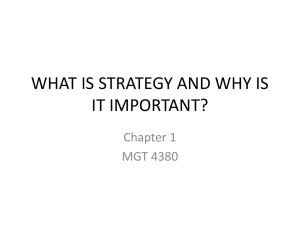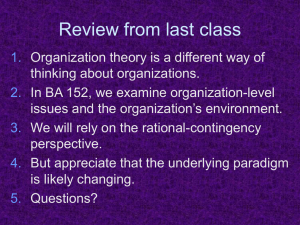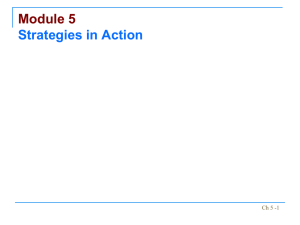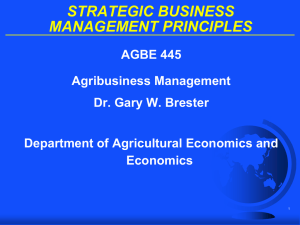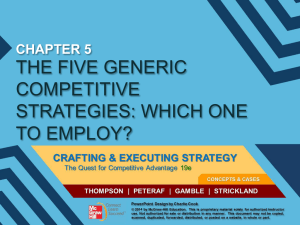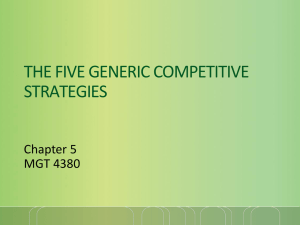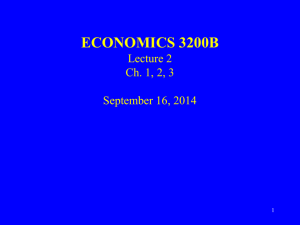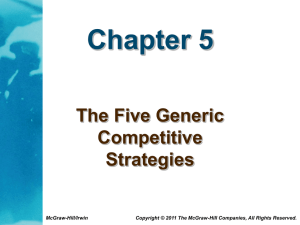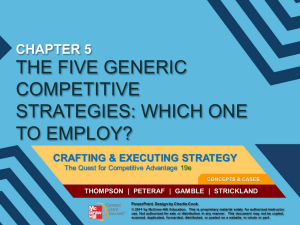Lecture 4
advertisement
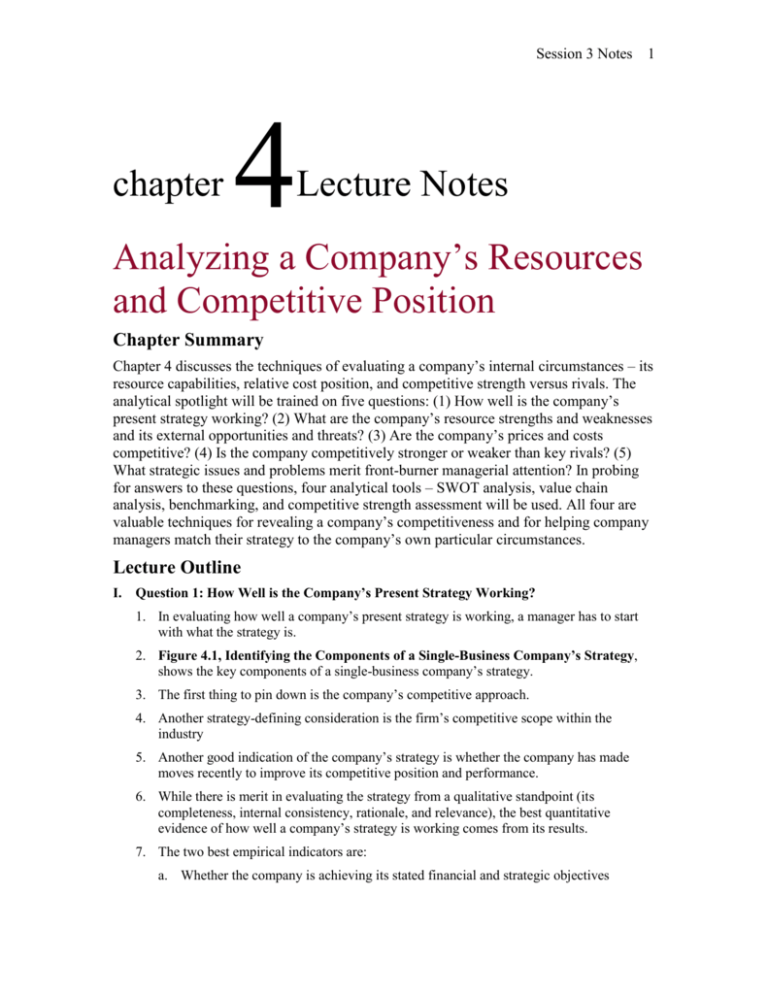
Session 3 Notes chapter 4 1 Lecture Notes Analyzing a Company’s Resources and Competitive Position Chapter Summary Chapter 4 discusses the techniques of evaluating a company’s internal circumstances – its resource capabilities, relative cost position, and competitive strength versus rivals. The analytical spotlight will be trained on five questions: (1) How well is the company’s present strategy working? (2) What are the company’s resource strengths and weaknesses and its external opportunities and threats? (3) Are the company’s prices and costs competitive? (4) Is the company competitively stronger or weaker than key rivals? (5) What strategic issues and problems merit front-burner managerial attention? In probing for answers to these questions, four analytical tools – SWOT analysis, value chain analysis, benchmarking, and competitive strength assessment will be used. All four are valuable techniques for revealing a company’s competitiveness and for helping company managers match their strategy to the company’s own particular circumstances. Lecture Outline I. Question 1: How Well is the Company’s Present Strategy Working? 1. In evaluating how well a company’s present strategy is working, a manager has to start with what the strategy is. 2. Figure 4.1, Identifying the Components of a Single-Business Company’s Strategy, shows the key components of a single-business company’s strategy. 3. The first thing to pin down is the company’s competitive approach. 4. Another strategy-defining consideration is the firm’s competitive scope within the industry 5. Another good indication of the company’s strategy is whether the company has made moves recently to improve its competitive position and performance. 6. While there is merit in evaluating the strategy from a qualitative standpoint (its completeness, internal consistency, rationale, and relevance), the best quantitative evidence of how well a company’s strategy is working comes from its results. 7. The two best empirical indicators are: a. Whether the company is achieving its stated financial and strategic objectives Session 3 Notes 2 b. Whether the company is an above-average industry performer 8. Other indicators of how well a company’s strategy is working include: a. Whether the firm’s sales are growing faster, slower, or about the same pace as the market as a whole b. Whether the company is acquiring new customers at an attractive rate as well as retaining existing customers c. Whether the firm’s profit margins are increasing or decreasing and how well its margins compare to rival firms’ margins d. Trends in the firm’s net profits and returns on investment and how these compare to the same trends for other companies in the industry e. Whether the company’s overall financial strength and credit rating are improving or on the decline f. Whether the company can demonstrate continuous improvement in such internal performance measures as days of inventory, employee productivity, unit costs, defect rate, scrap rate, misfilled orders, delivery times, warranty costs, and so on g. How shareholder’s view the company based on trends in the company’s stock price and shareholder value h. The firm’s image and reputation with its customers i. How well the company stacks up against rivals on technology, product innovation, customer service, product quality, delivery time, getting newly developed products to market quickly, and other relevant factors on which buyers base their choice of brands 9. The stronger a company’s current overall performance, the less likely the need for radical changes in strategy. The weaker a company’s financial performance and market standing, the more its current strategy must be questioned. Weak performance is almost always a sign of weak strategy, weak execution, or both. CORE CONCEPT: The stronger a company’s financial performance and market position, the more likely it has a well-conceived, well-executed strategy. II. Question 2: What are the Company’s Resource Strengths and Weaknesses and Its External Opportunities and Threats 1. Appraising a company’s resource strengths and weaknesses and its external opportunities and threats, commonly known as SWOT analysis, provides a good overview of whether its overall situation is fundamentally healthy or unhealthy. CORE CONCEPT: SWOT analysis is a simple but powerful tool for sizing up a company’s resource capabilities and deficiencies, its market opportunities, and the external threats to its future well-being. 2. A first-rate SWOT analysis provides the basis for crafting a strategy that capitalizes on the company’s resources, aims squarely at a capturing the company’s best opportunities, and defends against the threats to its well being. A. Identifying Company Resource Strengths and Competitive Capabilities Session 3 Notes 3 1. A strength is something a company is good at doing or an attribute that enhances its competitiveness. A strength can take any of several forms: a. A skill or important expertise b. Valuable physical assets c. Valuable human assets d. Valuable organizational assets e. Valuable intangible assets f. Competitive capabilities g. An achievement or attribute that puts the company in a position of market advantage h. Competitively valuable alliances or cooperative ventures 2. Taken together, a company’s strengths determine the complement of competitively valuable resources with which it competes – a company’s resource strengths represent competitive assets. CORE CONCEPT: A company is better positioned to succeed if it has a competitively valuable complement of resources at its command. 3. The caliber of a firm’s resource strengths and competitive capabilities, along with its ability to mobilize them in the pursuit of competitive advantage, are big determinants of how well a company will perform in the marketplace. 4. Company Competencies and Competitive Capabilities: Sometimes a company’s resource strengths relate to fairly specific skills and expertise and sometimes they flow from pooling the knowledge and expertise of different organizational groups to create a company competence or competitive capability. 5. Company competencies can range from merely a competence in performing an activity to a core competence to a distinctive competence. a. A competence is something an organization is good at doing. It is nearly always the product of experience, representing an accumulation of learning and the buildup of proficiency in performing an internal activity. CORE CONCEPT: A competence, something the organization is good at, is nearly always the product of experience b. A core competence is a proficiently performed internal activity that is central to a company’s strategy and competitiveness. A core competence is a more valuable resource strength than a competence because of the well-performed activity’s core role in the company’s strategy and the contributions it makes to the company’s success in the marketplace. CORE CONCEPT: A core competence is a competitively important activity that a company performs better than other internal activities. c. A distinctive competence is a competitively valuable activity that a company performs better than its rivals. A distinctive competence represents a competitively superior resource strength. Session 3 Notes 4 CORE CONCEPT: A distinctive competence is something that a company does better than its rivals. 6. The conceptual differences between a competence, a core competence, and a distinctive competence draw attention to the fact that competitive capabilities are not all equal. 7. Core competencies are competitively more important than simple competencies because they add power to the company’s strategy and have a bigger positive impact on its market position and profitability. 8. The importance of a distinctive competence to strategy-making rests with: a. The competitively valuable capability it gives a company b. Its potential for being the cornerstone of strategy c. The competitive edge it can produce in the marketplace 9. What is the Competitive Power of Resource Strength? What is most telling about a company’s strengths is how competitively powerful they are in the marketplace. 10. The competitive power of a company strength is measured by how many of the following four tests it can pass: a. Is the resource strength hard to copy? b. Is the resource strength durable – does it have staying power? c. Is the resource really competitively superior? d. Can the resource strength be trumped by different resource strengths and competitive capabilities of rivals? 11. The vast majority of companies are not well endowed with competitively valuable resources, much less with competitively superior resources capable of passing all four tests with high marks. Most firms have a mixed bag of resources. 12. Only a few companies, usually the strongest industry leaders or up-and-coming challengers, possess a distinctive competence or competitively superior resource. 13. Sometimes a company derives significant competitive vitality, maybe even a competitive advantage, from a collection of good-adequate resources that collectively have competitive power in the marketplace. CORE CONCEPT: A company’s success in the marketplace becomes more likely when it has appropriate and ample resources with which to compete and especially when it has strengths and capabilities with competitive advantage. B. Identifying Company Resource Weaknesses and Competitive Deficiencies 1. A weakness or competitive deficiency is something a company lacks or does poorly in comparison to others or a condition that puts it at a disadvantage in the marketplace. 2. A company’s weaknesses can relate to: a. Inferior or unproven skills or expertise or intellectual capital in competitively important areas of the business b. Deficiencies in competitively important physical, organizational, or intangible assets c. Missing or competitively inferior capabilities in key areas Session 3 Notes 5 3. Internal weaknesses are shortcomings in a company’s complement of resources and represent competitive liabilities. CORE CONCEPT: A company’s resource strengths represent competitive assets; its resource weaknesses represent competitive liabilities. 4. Table 4.1, What to Look for in Identifying a Company’s Strengths, Weaknesses, Opportunities, and Threats, lists the kinds of factors to consider in compiling a company’s resource strengths and weaknesses. C. Identifying a Company’s Market Opportunities 1. Market opportunity is a big factor in shaping a company’s strategy. 2. Managers cannot properly tailor strategy to the company’s situation without first identifying its opportunities and appraising the growth and profit potential each one holds. 3. In evaluating a company’s market opportunities and ranking their attractiveness, managers have to guard against viewing every industry opportunity as a company opportunity. 4. Opportunities can be plentiful or scarce and can range from wildly attractive to marginally interesting to unsuitable. CORE CONCEPT: A company is well advised to pass on a particular market opportunity unless it has or can acquire the resources to capture it. 5. The market opportunities most relevant to a company are those that match up well with the company’s financial and organizational resource capabilities, offer the best growth and profitability, and present the most potential for competitive advantage. D. Identifying Threats to a Company’s Future Profitability 1. Certain factors in a company’s external environment pose threats to its profitability and competitive well-being. 2. Examples of threats include: the emergence of cheaper or better technologies, rivals’ introduction of new or improved products, lower-cost foreign competitors’ entry into a company’s market stronghold, new regulations that are more burdensome to a company than to its competitors, vulnerability to a rise in interest rates, the potential of a hostile takeover, unfavorable demographic shifts, adverse changes in foreign exchange rates, political upheaval in a foreign country where the company has facilities, and so on. 3. It is management’s job to identify the threats to the company’s future profitability and to evaluate what strategic actions can be taken to neutralize or lessen their impact. E. What Do the SWOT Listings Reveal? 1. SWOT analysis involves more than making four lists. The two most important parts of SWOT analysis are: a. Drawing conclusions from the SWOT listings about the company’s overall situation b. Acting on those conclusions to better match the company’s strategy to its resource strengths and market opportunities, to correct important weaknesses, and to defend against external threats Session 3 Notes 6 CORE CONCEPT: Simply making lists of a company’s strengths, weaknesses, opportunities, and threats is not enough; the payoff from SWOT analysis comes from the conclusions about a company’s situation and the implications for a strategy improvement that flow from the four lists. 2. Figure 4.2, The Three Steps of SWOT Analysis: Identify, Draw Conclusions, Translate Into Strategic Action, shows the three steps of SWOT analysis. 3. Just what story the SWOT analysis tells about the company’s overall situation can be summarized in a series of questions: a. Does the company have an attractive set of resource strengths? b. How serious are the company’s weaknesses and competitive deficiencies? c. Do the company’s resource strengths and competitive capabilities outweigh its resource weaknesses and competitive deficiencies by an attractive margin? d. Does the company have attractive market opportunities that are well suited to its resource strengths and competitive capabilities? e. Are the threats alarming or are they something the company appears able to deal with and defend against? f. How strong is the company’s overall situation? 4. Implications for SWOT analysis for strategic action: a. Which competitive capabilities need to be strengthened immediately? b. What actions should be taken to reduce the company’s competitive liabilities? c. Which market opportunities should be top priority in future strategic initiatives? Which opportunities should be ignored? d. What should the company be doing to guard against the threats to its well-being? 5. A company’s resource strengths should generally form the cornerstones of strategy because they represent the company’s best chance for market success. 6. Sound strategy making requires sifting thorough the available market opportunities and aiming strategy at capturing those that are most attractive and suited to the company’s circumstances. III. Question 3: Are the Company’s Prices and Costs Competitive? 1. One of the most telling signs of whether a company’s business position is strong or precarious is whether its prices and costs are competitive with industry rivals. 2. Price-cost comparisons are especially critical in a commodity-product industry where the value provided to buyers is the same from seller to seller, price competition is typically the ruling force and lower-cost companies have the upper hand. CORE CONCEPT: The higher a company’s costs are above those of close rivals, the more competitively vulnerable it becomes. 3. Two analytical tools are particularly useful in determining whether a company’s prices and costs are competitive and thus conducive to winning in the marketplace: value chain analysis and benchmarking. A. The Concept of a Company’s Value Chain Session 3 Notes 7 1. A company’s value chain consists of the linked set of value-creating activities the company performs internally. CORE CONCEPT: A company’s value chain identifies the primary activities that create customer value and the related support activities. 2. Figure 4.3, A Representative Company Value Chain, depicts the linked set of value creating activities. 3. The value chain consists of two broad categories of activities: a. Primary activities: foremost in creating value for customers b. Support activities: facilitate and enhance the performance of primary activities 4. Disaggregating a company’s operations into primary and secondary activities exposes the major elements of the company’s cost structure. 5. The combined costs of all of the various activities in a company’s value chain define the company’s internal cost structure. 6. The tasks of value chain analysis and benchmarking are to develop the data for comparing a company’s costs, activity by activity, against the costs of key rivals and to learn which internal activities are a source of cost advantage or disadvantage. B. Why the Value Chains of Rival Companies Often Differ 1. A company’s value chain and the manner in which it performs each activity reflect the evolution of its own particular business and internal operations, its strategy, the approaches it is using to execute its strategy, and the underlying economics of the activities themselves. 2. Because these factors differ from company to company, the value chain of rival companies sometimes differ substantially – a condition that complicates the task of assessing rivals’ relative cost positions. C. The Value Chain System for an Entire Industry 1. Accurately assessing a company’s competitiveness in end-use markets requires that company managers understand the entire value chain system for delivering a product or service to end-users, not just the company’s own value chain. 2. Figure 4.4, A Representative Value Chain for an Entire Industry, explores a value chain for an entire industry. CORE CONCEPT: A company’s cost competitiveness depends not only on the costs of internally performed activities (its own value chain) but also on costs in the value chain of its suppliers and forward channel allies. 3. Suppliers’ value chains are relevant because suppliers perform activities and incur costs in creating and delivering the purchased inputs used in a company’s own value chain. 4. Forward channel and customer value chains are relevant because: a. The costs and margins of a company’s distribution allies are part of the price the end user pays b. The activities that distribution allies perform affect the end user’s satisfaction Session 3 Notes 8 5. Actual value chains vary by industry and by company. Generic value chains like those in Figures 3.3 and 3.4 are illustrative, not absolute and have to be drawn to fit the activities of a particular company or industry. D. Developing the Data to Measure a Company’s Cost Competitiveness 1. The next step in evaluating a company’s cost competitiveness involves disaggregating or breaking down departmental cost accounting data into the costs of performing specific activities. 2. A good guideline is to develop separate cost estimates for activities having different economics and for activities representing a significant or growing proportion to cost. 3. Traditional accounting identifies costs according to broad categories of expense. A newer method, activity-based costing, entails defining expense categories according to the specific activities being performed and then assigning costs to the activity responsible for creating the cost. 4. Table 4.2, The Differences between Traditional Cost Accounting and Activity-Based Cost Accounting: A Purchasing Department Example, provides an illustrative example of the difference between traditional cost accounting and activity-based accounting. 5. Perhaps 25% of the companies that have explored the feasibility of activity-based costing have adopted this accounting approach. 6. Illustration Capsule 4.1, Value Chain Costs for Companies in the Business of Recording and Distributing Music CDs, shows representative costs for various activities performed by the producers and marketers of music CDs. Illustration Capsule 4.1, Value Chain Costs for Companies in the Business of Recording and Distributing Music CDs Discussion Question 1. What are the total costs associated with direct production to a record company when producing a music CD? Why is having this knowledge important to such a company? Answer: According to the information provided in the table, a record company’s direct production costs equal $2.40 per CD. This information is important because a company most know its actual and correct costs of production in order to establish fair product pricing in the marketplace. 7. The most important application of value chain analysis is to explore how a particular firm’s cost position compares with the cost position of its rivals. E. Benchmarking the Costs of Key Value Chain Activities 1. Benchmarking is a tool that allows a company to determine whether the manner in which it performs particular functions and activities represent industry “best practices” when both cost and effectiveness are taken into account. CORE CONCEPT: Benchmarking has proved to be a potent tool for learning which companies are best at performing particular activities and then using their techniques or “best practices” to improve the cost and effectiveness of a company’s own internal activities. Session 3 Notes 9 2. Benchmarking entails comparing how different companies perform various value chain activities. 3. The objectives of benchmarking are: a. To identify the best practices in performing an activity b. To learn how other companies have actually achieved lower costs or better results in performing benchmarked activities c. To take action to improve a company’s competitiveness whenever benchmarking reveals that its costs and results of performing an activity do not match those of other companies 4. Benchmarking has quickly come to be a tool for comparing a company against rivals not only on cost but also on most any relevant activity or competitively important measure. 5. The tough part of benchmarking is not whether to do it but rather how to gain access to information about other companies practices and costs. CORE CONCEPT: Benchmarking the costs of company activities against rivals provides hard evidence of a company’s cost-competitiveness. 6. Sometimes benchmarking can be accomplished by collecting information from published reports, trade groups, and industry research firms and by talking to knowledgeable industry analysts, customers, and suppliers. 7. Making reliable cost comparisons is complicated by the fact that participants often use different cost accounting systems. 8. The explosive interest of companies in benchmarking costs and identifying best practices has prompted consulting organizations to gather benchmarking data, do benchmarking studies, and distribute information about best practices without identifying sources. Having an independent group gather the information and report it in a manner that disguises the names of individual companies permits participating companies to avoid disclosing competitively sensitive data to rivals and reduces the risk of ethical problems. 9. Illustration Capsule 4.2, Benchmarking and Ethical Conduct, lists some guidelines with regard to benchmarking and ethical conduct. Illustration Capsule 4.2, Benchmarking and Ethical Conduct Discussion Question 1. Identify why ethical conduct is important in benchmarking. Answer: In a benchmarking situation, ethical conduct is important because the discussion between benchmarking partners can involve competitively sensitive data that can conceivably raise questions about possible restraint of trade or improper business conduct. F. Strategic Options for Remedying a Cost Disadvantage 1. Value chain analysis and benchmarking can reveal a great deal about a firm’s cost competitiveness. Session 3 Notes 10 2. There are three main areas in a company’s overall value chain where important differences in the costs of competing firms can occur: a company’s own activity segments, suppliers’ part of the industry value chain, and the forward channel portion of the industry chain. 3. When the source of a firm’s cost disadvantage is internal, managers can use any of the following eight strategic approaches to restore cost parity: a. Implement the use of best practices throughout the company, particularly for highcost activities b. Try to eliminate some cost-producing activities altogether by revamping the value chain c. Relocate high-cost activities to geographic areas where they can be performed more cheaply d. Search out activities that can be outsourced from vendors or performed by contractors more cheaply than they can be done internally e. Invest in productivity-enhancing, cost-saving technological improvements f. Innovate around the troublesome cost components g. Simplify the product design so that it can be manufactured or assembled quickly and more economically h. Try to make up the internal cost disadvantage by achieving savings in the other two parts of the value chain system 4. If a firm finds that it has a cost disadvantage stemming from costs in the supplier or forward channel portions of the industry value chain, then the task of reducing its costs to levels more in line with competitors usually has to extend beyond the firm’s own inhouse operations. 5. Table 4.3, Options for Attacking Cost Disadvantages Associated with Supply Chain Activities or Forward Channel Allies, presents the strategy options for attacking high costs associated with supply chain activities or forward channel allies. G. Translating Proficient Performance of Value Chain Activities into Competitive Advantage 1. A company that does a first-rate job of managing its value chain activities relative to competitors stands a good chance of leveraging its competitively valuable competencies and capabilities into sustainable competitive advantage. CORE CONCEPT: Performing value chain activities in ways that give a company the capabilities to outmatch rivals is a source of competitive advantage. 2. Figure 4.5, Translating Company Performance of Value Chain Activities into Competitive Advantage, shows the process of translating proficient company performance into competitive advantage. 3. The road to competitive advantage begins with management efforts to build more organizational expertise in performing certain competitively important value chain activities, deliberately striving to develop competencies and capabilities that add power to its strategy and competitiveness. IV. Question 4: Is the Company Competitively Stronger or Weaker Than Key Rivals? Session 3 Notes 11 1. Using value chain analysis and benchmarking to determine a company’s competitiveness on price and cost is necessary but not sufficient. 2. The answers to two questions are of particular interest: a. How does the company rank relative to competitors on each of the important factors that determine market success? b. Does the company have a net competitive advantage or disadvantage vis-à-vis major competitors? 3. An easy method for answering the questions posed above involves developing quantitative strength ratings for the company and its key competitors on each industry key success factor and each competitively decisive resource capability. 4. The followings are steps for compiling a competitive strength assessment: a. Step 1: make a list of the industry’s key success factors and most telling measures of competitive strength or weakness b. Step 2: rate the firm and its rivals on each factor c. Step 3: sum the strength ratings on each factor to get an overall measure of competitive strength for each company being rated d. Step 4: use the overall strength ratings to draw conclusions about the size and extent of the company’s net competitive advantage or disadvantage and to take specific note of areas of strengths and weaknesses 5. Table 4.4, Illustrations of Unweighted and Weighted Competitive Strength Assessments, provides two examples of competitive strength assessment. 6. A better method is a weighted rating system because the different measures of competitive strength are unlikely to be equally important. CORE CONCEPT: A weighted competitive strength analysis is conceptually stronger than an unweighted analysis because of the inherent weakness in assuming that all the strength measures are equally important. 7. No matter whether the differences between the important weights are big or little, the sum of the weights must equal 1.0. 8. Weighted strength ratings are calculated by rating each competitor on each strength measure and multiplying the assigned rating by the assigned weight. 9. Summing a company’s weighted strength ratings for all the measures yields an overall strength rating. Comparisons of the weighted overall strength scores indicate which competitors are in the strongest and weakest competitive positions and who has how big a net competitive advantage over whom. 10. Competitive strength assessments provide useful conclusions about a company’s competitive situation. 11. Knowing where a company is competitively strong or weak in comparison to specific rivals is valuable in deciding on specific actions to strengthen its ability to compete. CORE CONCEPT: High competitive strength ratings signal a strong competitive position and possession of competitive advantage; low ratings signal a weak position and competitive disadvantage. Session 3 Notes 12 12. The competitive strength ratings point to which rival companies may be vulnerable to competitive attack and the areas where they are weakest. V. Question 5: What Strategic Issues and Problems Merit Front-Burner Managerial Attention? 1. The final and most important analytical step is to zero in on exactly what strategic issues that company managers need to address and resolve for the company to be more financially and competitively successful in the years ahead. 2. This step involves drawing on the results of both industry and competitive analysis and the evaluations of the company’s own competitiveness. 3. Pinpointing the precise problems that management needs to worry about sets the agenda for deciding what actions to take next to improve the company’s performance and business outlook. CORE CONCEPT: Zeroing in on the strategic issues a company faces and compiling a “worry list” of problems and roadblocks creates a strategic agenda of problems that merit prompt managerial attention. 4. The “worry list” of issues and problems can include such things as: a. How to stave off market challenges from new foreign competitors b. How to combat rivals’ price discounting c. How to reduce the company’s high costs to pave the way for price reductions d. How to sustain the company’s present growth rate in light of slowing buyer demand e. Whether to expand the company’s product line f. Whether to acquire a rival company to correct the company’s competitive deficiencies g. Whether to expand into foreign markets rapidly or cautiously h. Whether to reposition the company and move to a different strategic group i. What to do about the aging demographics of the company’s customer base CORE CONCEPT: A good strategy must contain ways to deal with all the strategic issues and obstacles that stand in the way of the company’s financial and competitive success in the years ahead. Exercises Review the information in Illustration Capsule 4.1 concerning the costs of the different value chain activities associated with recording and distributing music CDs through traditional brick-and-mortar retail outlets. Then answer the following questions: 1. Does the growing popularity of downloading music from the Internet give rise to a new music industry value chain that differs considerably from the traditional value chain? Explain why or why not. The students may draw hypothetical value chains such as the ones depicted in Figure 4.3 and Figure 4.4 to demonstrate their chosen responses. However, the responses should specify that major changes are to be expected in all areas of the value chain. The provided responses should indicate that the process of downloading music versus selling from brick-and-mortar Session 3 Notes 13 businesses alters not only supplier-related value chains as well as the company’s own value chain, but also forward channel value chains. The new process relatively cuts out many or all supplier-related costs and distribution-related expenses. Suggested responses may include: (1) decreased company direct production costs such as no costs associated with pressing of CDs and packaging, (2) decreased or no marketing expenses, (3) decreased company overhead, (4) no costs associated with distributors, and (5) no distributor markup reflected in average price to the end-user of the product. 2. What costs are being cut out of the traditional value chain or bypassed as recording studios begin to sell downloadable files of artists’ recordings and buyers make their own custom CDs (or play music directly from their PCs)? Suggested costs expected to be cut from the value chain include: (1) costs associated with pressing and packaging of the CDs, (2) decreased or no marketing expenses associated with the product, (3) no costs associated with distribution of the CDs, (4) decreased company overhead, and (5) no distributor markups that are passed on to the consumers. 3. How much more cost-effective is the value chain for selling downloadable files direct to consumers than the traditional industry value chain? Suggested student responses should identify the downloadable music files direct to the consumer is more cost-effective than the traditional manner of generating sales revenue. Students again should reference their indicated differences in costs associated with the two value chains. 4. What do you think the growing popularity of downloading music from the Internet is doing to the competitiveness and future business prospects of brick-and-mortar retail music chains? Suggested student responses may indicate that the new process will greatly impact the competitiveness of businesses in the music industry; those companies maintaining the old manner of conducting business will have higher prices and costs associated with each individual product. Future business prospects will also be greatly impacted by the new process and will be altered or reduced. Session 3 Notes chapter 5 14 Lecture Notes The Five Generic Competitive Strategies Chapter Summary Chapter 5 describes the five basic competitive strategy options – which of the five to employ is a company’s first and foremost choice in crafting overall strategy and beginning its quest for competitive advantage. Lecture Outline I. Introduction 1. By competitive strategy we mean the specifics of management’s game plan for competing successfully – how it plans to position the company in the marketplace, its specific efforts to please customers, and improve its competitive strength, and the type of competitive advantage it wants to establish. CORE CONCEPT: A competitive strategy concerns the specifics of management’s game plan for competing successfully and achieving a competitive edge over rivals. 2. A company achieves competitive advantage whenever it has some type of edge over rivals in attracting buyers and coping with competitive forces. 3. There are many routes to competitive advantage, but they all involve giving buyers what they perceive as superior value. 4. Delivering superior value – whatever form it takes – nearly always requires performing value chain activities differently than rivals and building competencies and resource capabilities that are not readily matched. II. Five Competitive Strategies 1. There are countless variations in the competitive strategies that companies employ, mainly because each company’s strategic approach entails custom-designed actions to fit its own circumstances and industry environment. 2. The biggest and most important differences among competitive strategies boil down to: a. Whether a company’s market target is broad or narrow b. Whether the company is pursuing a competitive advantage linked to low costs or product differentiation 3. Five distinct competitive strategy approaches stand out: Session 3 Notes 15 a. A low-cost provider strategy: appealing to a broad spectrum of customers based by being the overall low-cost provider of a product or service b. A broad differentiation strategy: seeking to differentiate the company’s product/service offering from rivals’ in ways that will appeal to a broad spectrum of buyers c. A best-cost provider strategy: giving customers more value for the money by incorporating good-to-excellent product attributes at a lower cost than rivals; the target is to have the lowest (best) costs and prices compared to rivals offering products with comparable attributes d. A focused or market niche strategy based on lower cost: concentrating on a narrow buyer segment and outcompeting rivals by serving niche members at a lower cost than rivals e. A focused or market niche strategy based on differentiation: concentrating on a narrow buyer segment and outcompeting rivals by offering niche members customized attributes that meet their tastes and requirements better than rivals products 4. Figure 5.1, The Five Generic Competitive Strategies — Each Stakes Out a Different Position in the Marketplace, examines how each of the five strategies stake out a different market position. III. Low-Cost Provider Strategies 1. A company achieves low-cost leadership when it becomes the industry’s lowest-cost provider rather than just being one of perhaps several competitors with comparatively low costs. 2. In striving for a cost advantage over rivals, managers must take care to include features that buyers consider essential. 3. For maximum effectiveness, companies employing a low-cost provider strategy need to achieve their cost advantage in ways difficult for rivals to copy or match. CORE CONCEPT: A low-cost leader’s basis for competitive advantage is lower overall costs than competitors. Successful low-cost leaders are exceptionally good at finding ways to drive costs out of their businesses. 4. A company has two options for translating a low-cost advantage over rivals into attractive profit performance: a. Option 1: use the lower-cost edge to underprice competitors and attract pricesensitive buyers in great numbers to increase total profits b. Option 2: maintain the present price, be content with the current market share, and use the lower-cost edge to earn higher profit margin on each unit sold 5. Illustration Capsule 5.1, Nucor Corporation’s Low-Cost Provider Strategy, describes Nucor Corporation’s strategy for gaining low-cost leadership in manufacturing a variety of steel products. Illustration Capsule 5.1, Nucor Corporation’s Low-Cost Provider Strategy Discussion Question 1. What is the aim of Nucor’s low-cost strategy? Session 3 Notes 16 Answer: Nucor’s low-cost strategy aims to give the organization a cost and pricing advantage in the commodity-like steel industry. In order to accomplish this, it leaves no part of the company’s value chain neglected. A. The Two Major Avenues for Achieving a Cost Advantage 1. To achieve a cost advantage, a firm must make sure that its cumulative costs across its overall value chain are lower than competitors’ cumulative costs. There are two ways to accomplish this: a. Outmanage rivals in efficiency with which value chain activities are performed and in controlling the factors driving the costs of value chain activities b. Revamp the firm’s overall value chain to eliminate or bypass some cost-producing activities 2. Controlling the Cost Drivers: There are nine major cost drivers that come into play in determining a company’s costs in each activity segment of the value chain: a. Economies or diseconomies of scale – The costs of a particular value chain activity are often subject to economies or diseconomies of scale. b. Learning and experience curve effects – The cost of performing an activity can decline over time as the experience of company personnel builds. c. The cost of key resource inputs – The cost of performing value chain activities depends in part on what a firm has to pay for key resource inputs: i. Union versus nonunion labor ii. Bargaining power vis-à-vis suppliers iii. Locational variables iv. Supply chain management expertise d. Links with other activities in the company or industry value chain – When the cost of one activity is affected by how other activities are performed, costs can be managed downward by making sure that linked activities are performed in cooperative and coordinated fashion. e. Sharing opportunities with other organizational or business units within the enterprise – Different product lines or business units within an enterprise can often share the same order processing and customer billing systems, maintain a common sales force to call on customers, share the same warehouse and distribution facilities, or rely on a common customer service and technical support team. f. The benefits of vertical integration versus outsourcing – Vertical integration (expanding backward into sources of supply, forward to end-users, or both) allows affirm to bypass suppliers or buyers with considerable bargaining power. Most often it is cheaper to outsource or hire outside specialists to perform certain functions and activities. CORE CONCEPT: Vertical integration is the backward expansion into sources of supply, the forward expansion toward end users, or both. CORE CONCEPT: To outsource is to hire outside specialists to perform certain functions critical to the firm rather than performing them in-house. Session 3 Notes 17 g. First-mover advantages and disadvantages – Sometimes the first major brand in the market is able to establish and maintain its brand name at a lower cost than later brand arrivals. h. The percentage of capacity utilization – Capacity utilization is a big cost driver for those value chain activities associated with substantial fixed costs. i. Strategic choices and operating decisions – A company’s cost can be driven up or down by a fairly wide assortment of managerial decisions: i. Adding/cutting the services provided to buyers ii. Incorporating more/fewer performance and quality features into the product iii. Increasing/decreasing the number of different channels utilized in distributing the firm’s product iv. Lengthening/shortening delivery times to customers v. Putting more/less emphasis than rivals on the use of incentive compensation, wage increases, and fringe benefits to motivate employees and boost worker productivity vi. Raising/lowering the specifications for purchased materials CORE CONCEPT: Outperforming rivals in controlling the factors that drive costs is a very demanding managerial exercise. 3. Revamping the Value Chain: Dramatic costs advantages can emerge from finding innovative ways to eliminate or bypass cost-producing value chain activities. The primary ways companies can achieve a cost advantage by reconfiguring their value chains include: a. Making greater use of Internet technology applications – In recent years the Internet has become a powerful and pervasive tool for reengineering company and industry value chains. i. Illustration Capsule 5.2, Utz Quality Foods’ Use of Internet Technology to Reengineer Value Chain Activities, describes how one company is using Internet technology to improve both the effectiveness and the efficiency of the activities comprising its potato chip business. Illustration Capsule 5.2, Utz Quality Foods’ Use of Internet Technology to Reengineer Value Chain Activities Discussion Question 1. Identify the advantages obtained by Utz Quality Foods through the reengineering of the value chain via utilization of the newest technology? Answer: The advantages obtained by Utz include cost saving efficiencies, improved effectiveness of operations, and sales are boosted. b. Using direct-to-end-user sales and marketing approaches – Costs in the wholesaleretail portions of the value chain frequently represent 35-50 percent of the price final consumers pay. Session 3 Notes 18 c. Simplifying product design – Using computer-assisted design techniques, reducing the number of parts, standardizing parts and components across models and styles, and shifting to an easy-to-manufacture product design can all simplify the value chain. d. Stripping away the extras – Offering only basic products or services can help a company cut costs associated with multiple features and options. e. Shifting to a simpler, less capital intensive, or more streamlined or flexible technological process – Computer-assisted design and manufacture, or other flexible manufacturing systems, can accommodate both low-cost efficiency and product customization. f. Bypassing the use of high-cost raw materials or component parts – High-cost raw materials and parts can be designed out of the product. g. Relocating facilities – Moving plants closer to suppliers, customers, or both can help curtail inbound and outbound logistics costs. h. Dropping the “something for everyone” approach – Pruning slow-selling items from the product lineup and being content to meet the needs of most buyers rather than all buyers can eliminate activities and costs associated with numerous product versions. 4. Examples of Companies That Created New Value Chain Systems and Reduced Costs: One example of accruing significant cost advantages from creating altogether new value chain systems can be found in the beef-packing industry. Southwest Airlines has reconfigured the traditional value chain of commercial airlines to lower costs and thereby offer dramatically lower fares to passengers. Dell Computer has proved a pioneer in redesigning its value chain architecture in assembling and marketing personal computers. B. The Keys to Success in Achieving Low-Cost Leadership 1. To succeed with a low-cost provider strategy, company managers have to scrutinize each cost creating activity and determine what drives its cost. CORE CONCEPT: Success in achieving a low-cost edge over rivals comes from exploring avenues for cost reduction and pressing for continuous cost reductions across all aspects of the company’s value chain year after year. 2. While low-cost providers are champions of frugality, they are usually aggressive in investing in resources and capabilities that promise to drive costs out of the business. 3. Wal-Mart is one of the foremost practitioners of low-cost leadership. Other companies noted for their successful use of low-cost provider strategies include Lincoln Electric, Briggs & Stratton, Bic, Black & Decker, Stride Rite, Beaird-Poulan, and General Electric and Whirlpool. C. When a Low-Cost Provider Strategy Works Best 1. A competitive strategy predicated on low-cost leadership is particularly powerful when: a. Price competition among rival sellers is especially vigorous b. The products of rival sellers are essentially identical and suppliers are readily available from any of several eager sellers c. There are a few ways to achieve product differentiation that have value to buyers d. Most buyers use the product in the same ways Session 3 Notes 19 e. Buyers incur low costs in switching their purchases from one seller to another f. Buyers are large and have significant power to bargain down prices g. Industry newcomers use introductory low prices to attract buyers and build a customer base CORE CONCEPT: A low cost provider is in the best position to win the business of price-sensitive buyers, set the floor on market price, and still earn a profit. D. The Pitfalls of a Low-Cost Provider Strategy 1. Perhaps the biggest pitfall of a low-cost provider strategy is getting carried away with overly aggressive price cutting and ending up with lower, rather than higher, profitability. 2. A low-cost/low-price advantage results in superior profitability only if (1) prices are cut by less than the size of the cost advantage or (2) the added value gains in unit sales are large enough to bring in bigger total profit despite lower margins per unit sold. 3. A second big pitfall is not emphasizing avenues of cost advantages that can be kept proprietary or that relegate rivals to playing catch-up. 4. A third pitfall is becoming too fixated on cost reduction. 5. Even if these mistakes are avoided, a low-cost competitive approach still carries risk. CORE CONCEPT: A low-cost provider’s product offering must always contain enough attributes to be attractive to prospective buyers – low price, by itself, is not always appealing to buyers. IV. Differentiation Strategies 1. Differentiation strategies are attractive whenever buyers’ needs and preferences are too diverse to be fully satisfied by a standardized product or by sellers with identical capabilities. CORE CONCEPT: The essence of a broad differentiation strategy is to be unique in ways that are valuable to a wide range of customers. 2. Successful differentiation allows a firm to: a. Command a premium price for its product b. Increase unit sales c. Gain buyer loyalty to its brand 3. Differentiation enhances profitability whenever the extra price the product commands outweighs the added costs of achieving the differentiation. A. Types of Differentiation Themes 1. Companies can pursue differentiation from many angles. 2. The most appealing approaches to differentiation are those that are hard or expensive for rivals to duplicate. CORE CONCEPT: Easy to copy differentiating features cannot produce sustainable competitive advantage. B. Where along the Value Chain to Create the Differentiating Attributes Session 3 Notes 20 1. Differentiation opportunities can exist in activities all along an industry’s value chain; possibilities include the following: a. Supply chain activities that ultimately spill over to affect the performance or quality of the company’s end product. b. Product R&D activities that aim at improved product designs and performance features, expanded end uses and applications, more frequent first-on-the market victories, wider product variety and selection, added user safety, greater recycling capability, or enhanced environmental protection. c. Production R&D and technology-related activities that permit custom-order manufacture at an efficient cost, make production methods safer for the environment, or improve product quality, reliability, and appearance. d. Manufacturing activities that reduce product defects, prevent premature product failure, extend product life, allow better warranty coverages, improve economy of use, result in more end-user convenience, or enhance product appearance. e. Outbound logistics and distribution activities that allow for faster delivery, more accurate order filling, lower shipping costs, and fewer warehouse and on-the-shelf stockouts. f. Marketing, sales, and customer service activities that result in superior technical assistance to buyers, faster maintenance and repair services, more and better product information provided to customers, more and better training materials for end users, better credit terms, quicker order processing, or greater customer convenience. 4. Managers need keen understanding of the sources of differentiation and the activities that drive uniqueness to devise a sound differentiation strategy and evaluate various differentiation approaches. C. Achieving a Differentiation-Based Competitive Advantage 1. While it is easy enough to grasp that a successful differentiation strategy must entail creating buyer value in ways unmatched by rivals, the big question is which of four basic differentiating approaches to take in delivering unique buyer value. 2. One approach is to incorporate product attributes and user features that lower the buyer’s overall costs of using the product. 3. A second approach is to incorporate features that raise product performance. 4. A third approach is to incorporate features that enhance buyer satisfaction in noneconomic or intangible ways. 5. A fourth approach is to differentiate on the basis of capabilities – to deliver value to customers via competitive capabilities that rivals do not have or cannot afford to match. CORE CONCEPT: A differentiator’s basis for competitive advantage is either a product/service offering whose attributes differ significantly from the offering of rivals or a set of capabilities for delivering customer value that rivals do not have. D. The Importance of Perceived Value 1. Buyers seldom pay for value they do not perceive, no matter how real the unique extras may be. Thus, the price premium commanded by a differentiation strategy reflects the value actually delivered to the buyer and the value perceived by the buyer. Session 3 Notes 21 2. Signals of value that may be as important as actual value include: (1) when the nature of differentiation is subjective or hard to quantify, (2) when buyers are making first-time purchases, (3) when repurchase is infrequent, and (4) when buyers are unsophisticated. E. Keeping the Cost of Differentiation in Line 1. The trick to profitable differentiation is either to keep the costs of achieving differentiation below the price premium the differentiating attributes can command in the marketplace or to offset thinner profit margins with enough added volume to increase total profits. 2. It usually makes sense to incorporate differentiating features that are not costly but that add to buyer satisfaction. F. When a Differentiation Strategy Works Best 1. Differentiation strategies tend to work best in market circumstance where: a. There are many ways to differentiate the product or service and many buyers perceive these differences as having value b. Buyer needs and uses are diverse c. Few rival firms are following a similar differentiation approach d. Technological change and product innovation are fast-paced and competition revolves around rapidly evolving product features CORE CONCEPT: Any differentiating feature that works well tends to draw imitators. G. The Pitfalls of a Differentiation Strategy 1. There are no guarantees that differentiation will produce a meaningful competitive advantage. 2. If buyers see little value in the unique attributes or capabilities of a product then the company’s differentiation strategy will get a ho-hum market reception. 3. Attempts at differentiation are doomed to fail if competitors can quickly copy most or all of the appealing product attributes a company comes up with. 4. Other common pitfalls and mistakes in pursuing differentiation may include: a. Trying to differentiate on the basis of something that does not lower a buyer’s cost or enhance a buyer’s well being, as perceived by the buyer b. Overdifferentiating so that the product quality or service level exceeds buyers’ needs c. Trying to charge too high a price premium d. Being timid and not striving to open up meaningful gaps in quality or service or performance features vis-à-vis the products of rivals – tiny differences between rivals’ product offerings may not be visible or important to buyers 5. A low-cost provider strategy can defeat a differentiation strategy when buyers are satisfied with a basic product and do not think extra attributes are worth a higher price. V. Best-Cost Provider Strategies Session 3 Notes 22 1. Best-cost provider strategies aim at giving customers more value for the money. The objective is to deliver superior value to buyers by satisfying their expectations on key quality/service/features/performance attributes and beating their expectations on price. 2. A company achieves best-cost status from an ability to incorporate attractive attributes at a lower cost than rivals. 3. Best-cost provider strategies stake out a middle ground between pursuing a low-cost advantage and a differentiation advantage and between appealing to the broader market as a whole and a narrow market niche. 4. From a competitive positioning standpoint, best-cost strategies are a hybrid, balancing a strategic emphasis on low cost against a strategic emphasis on differentiation. 5. The market target is value-conscious buyers. 6. The competitive advantage of a best-cost provider is lower costs than rivals in incorporating good-to-excellent attributes, putting the company in a position to underprice rivals whose products have similar appealing attributes. 7. A best-cost provider strategy is very appealing in markets where buyer diversity makes product differentiation the norm and where many buyers are also sensitive to price and value. 8. Illustration Capsule 5.3, Toyota’s Best-Cost Producer Strategy for Its Lexus Line, describes how Toyota has used a best-cost approach with its Lexus models. Illustration Capsule 5.3, Toyota’s Best-Cost Producer Strategy for Its Lexus Line Discussion Question 1. Discuss how Toyota has been able to achieve its low-cost leadership status in the industry. Answer: Toyota has achieved low-cost leadership status because it has developed considerable skills in efficient supply chain management and low-cost assembly capabilities and because its models are so well-positioned in the low-to-medium end of the price spectrum. These are enhanced by Toyota’s strong emphasis on quality. A. The Big Risk of a Best-Cost Provider Strategy 1. The danger of a best-cost provider strategy is that a company using it will get squeezed between the strategies of firms using low-cost and differentiation strategies. 2. To be successful, a best-cost provider must offer buyers significantly better product attributes in order to justify a price above what low-cost leaders are charging. VI. Focused (or Market Niche) Strategies 1. What sets focused strategies apart from low-cost leadership or broad differentiation strategies is concentrated attention on a narrow piece of the total market. 2. The target segment or niche can be defined by: a. Geographic uniqueness b. Specialized requirements in using the product c. Special product attributes that appeal only to niche members A. A Focused Low-Cost Strategy Session 3 Notes 23 1. A focused strategy based on low cost aims at securing a competitive advantage by serving buyers in the target market niche at a lower cost and lower price than rival competitors. 2. This strategy has considerable attraction when a firm can lower costs significantly by limiting its customer base to a well-defined buyer segment. 3. Focused low-cost strategies are fairly common. 4. Illustration Capsule 5.4, Motel 6’s Focused Low-Cost Strategy, describes how Motel 6 has kept its costs low in catering to budget conscious travelers. Illustration Capsule 5.4, Motel 6’s Focused Low-Cost Strategy Discussion Question 1. Discuss the advantages this organization achieves from its focused low-cost provider strategy. Answer: Through utilization of this type of strategy, the Motel 6 organization is able to capitalize on the market segment that is comprised of price-conscious travelers who want clean, no-frills accommodations for a reasonable price. B. A Focused Differentiation Strategy 1. A focused strategy based on differentiation aims at securing a competitive advantage by offering niche members a product they perceive is better suited to their own unique tastes and preferences. 2. Successful use of a focused differentiation strategy depends on the existence of a buyer segment that is looking for special product attributes or seller capabilities and on a firm’s ability to stand apart from rivals competing in the same target market niche. 3. Illustration Capsule 5.5, Progressive Insurance’s Focused Differentiation Strategy in Auto Insurance, provides details about the company’s focused differentiation strategy. Illustration Capsule 5.5, Progressive Insurance’s Focused Differentiation Strategy in Auto Insurance Discussion Question 1. How does Progressive’s choice of strategy differentiate it from other insurance companies in the marketplace? Answer: Progressive’s choice of a focused differentiation strategy is one that caters to the more high-risk driver. Such drivers are not overly welcomed in the more traditional insurance companies of today. This company also has teams of roving claim adjusters to settle claims on the spot and offers motorcycle coverage as well as luxury car insurance. These are significantly different offerings from those of the more traditional insurance carriers that have been predominate within the industry. C. When A Focused Low-Cost or Focused Differentiation Strategy is Attractive 1. A focused strategy aimed at securing a competitive edge based either on low cost or differentiation becomes increasingly attractive as more of the following conditions are met: a. The target niche is big enough to be profitable and offers good growth potential Session 3 Notes 24 b. Industry leaders do not see that having a presence in the niche is crucial to their own success c. It is costly or difficult for multisegment competitors to put capabilities in place to meet specialized needs of the target market niche and at the same time satisfy the expectations of their mainstream customers d. The industry has many different niches and segments e. Few, if any, other rivals are attempting to specialize in the same target segment f. The focuser can compete effectively against challengers based on the capabilities and resources it has to serve the targeted niche and the customer goodwill it may have built up 4. When an industry has many different niches and segments, the strength of competition varies across and within segments, a condition that makes it important for a focuser to pick a niche that is both competitively attractive and well suited to its resource strengths and capabilities. CORE CONCEPT: Even though a focuser may be small, it still may have substantial competitive strength because of the attractiveness of its product offering and its strong, expertise and capabilities in meeting the needs and expectations of niche members. D. The Risks of a Focused Low-Cost or Focused Differentiation Strategy 1. Focusing carries several risks such as: a. The chance that competitors will find effective ways to match the focused firm’s capabilities in serving the target niche b. The potential for the preferences and needs of niche members to shift over time toward the product attributes desired by the majority of buyers c. The segment may become so attractive it is soon inundated with competitors, intensifying rivalry and splintering segment profits VII. The Contrasting Features of the Five Generic Competitive Strategies: A Summary 1. Deciding which generic competitive strategy should serve as the framework for hanging the rest of the company’s strategy is not a trivial matter. 2. Each of the five generic competitive strategies positions the company differently in its market and competitive environment. 3. Each establishes a central theme for how the company will endeavor to outcompete rivals. 4. Each creates some boundaries or guidelines for maneuvering as market circumstances unfold and as ideas for improving the strategy are debated. 5. Each points to different ways of experimenting and tinkering with the basic strategy. 6. Deciding which generic strategy to employ is perhaps the most important strategic commitment a company makes – it tends to drive the rest of the strategic actions a company decides to undertake. Session 3 Notes 25 7. Each entails differences in terms of product line, production emphasis, marketing emphasis, and means for sustaining the strategy. Table 5.1, Distinguishing Features of the Five Generic Strategies, examines the distinguishing features of each of the five generic strategies. 8. One of the big dangers here is that managers will opt for “stuck in the middle” strategies that represent compromises between lower costs and greater differentiation and between broad and narrow market appeal. 9. Only if a company makes a strong and unwavering commitment to one of the five generic competitive strategies does it stand much chance of achieving sustainable competitive advantage that such strategies can deliver if properly executed. Exercises 1. Go to www.google.com and do a search for “low-cost producer.” See if you can identify five companies that are pursuing a low-cost strategy in their respective industries. Suggested responses may include BNI Coal Mining, Coeur d’Alene Mining, Gordonstone Mines, Celestica, and Design Basics. The students should make note that this search does not necessarily generate the best or most easily understood information on the topic. 2. Using the advanced search engine function at www.google.com enter “best-cost producer” as an exact phrase and see if you can locate three companies that indicate they are employing a best-cost producer strategy. Suggested student responses may identify such choices as Emerson Electric, Astec Power, and Honeywell. Again, students should note that clear topic information is somewhat difficult to view, but numerous different companies are offered under this advanced search
